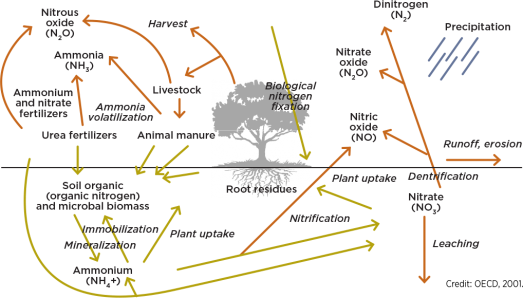Improve nitrogen use efficiency
Improved nitrogen use efficiency could provide a significant economic gain, given that nitrogen is one of canola growers’ single biggest input costs.
“Nutrient use efficiency from fertilizer application is generally less than 50 percent in the year it is applied. Improvements in nutrient use efficiency are therefore critical, both to improve the economics of crop production and to minimize the movement of nutrients into the air or water,” wrote Cindy Grant, S.S. Malhi and Jeff Schoenau in their 2010 review, “Improving nutrient use efficiency with enhanced efficiency fertilizers in the Northern Great Plains
of North America.”
If growers follow the traditional efficiency methods of in-soil banding (4R right placement) nitrogen in the spring (4R right timing), they will see limited benefit from an investment in enhanced efficiency products.
The benefit from enhanced efficiency products tends to increase when growers cannot — due to logistics, timing, weather or equipment — apply using traditional methods. In their review, Grant, Malhi and Schoenau provide the following examples:
- Seeding equipment with banders that can apply fertilizer separately from the seed row can be costly and may also increase draft requirements, soil distur-
bance and moisture loss. Enhanced efficiency fertilizers that allow the use
of simplified, less expensive equipment or practices (for example, seed-placed as compared to mid-row or side-band systems; surface applications rather than in-soil band) may be economically and operationally attractive. - By reducing the potential for nutrient loss, enhanced efficiency ferti-
lizers allow a single efficient application of fertilizer that becomes available over a longer period, increasing application timing flexibility. They can also be applied in the fall so growers don’t miss the spring window of application for split applications due to poor weather, physical conditions in the field, or time constraints.
Enhanced efficiency fertilizers
The three most widely available novel fertilizer formulations to improve N use efficiency are urease inhibitors, controlled release nitrogen and nitrification inhibitors. The following information on each is taken from the Grant, Malhi and Schoenau review.
Urease inhibitors. Urease inhibitors can be used in place of traditional management practices to decrease ammonia volatilization from surface applications and seedling damage from seed-placed ammonium or ammonium-producing N fertilizer. This could help growers reduce soil disturbance and application costs.
Urea will not volatilize or cause seedling damage until after it has been hydrolyzed to ammonium in a reaction catalyzed by the urease enzyme. Urease inhibitors slow the rate of hydrolysis to reduce the concentration of ammonium and ammonia present in the soil solution. This allows time for rainfall to move urea into the soil where the released ammonia will be less subject to volatilization, or for the urea to move away from the germinating seedling, reducing the risk of seedling damage.
Use of urease inhibitors with fall-banded urea may slow the release of ammonia and its subsequent conversion to nitrate, reducing the risk of nitrate leaching or denitrification.
Urease inhibitors are most likely to increase crop yield where yield potential is high, soil N levels are low, and soil and environmental conditions promote extensive volatilization. Potential volatilization, and hence potential benefits from the use of urease inhibitors, will be higher where: incorporation is difficult; where there is little opportunity for urea to move into the soil with infiltrating water; or where the soil has a high urease activity because of lack of cultivation or the accumulation of organic material. The risk of volatilization and seedling damage is higher on high pH, calcareous soils.
Controlled release nitrogen. The product currently available is polymer-coated urea, which releases urea fertilizer into the soil solution at a rate limited by moisture and controlled by soil temper-ature. Controlled release urea provides its greatest benefit under warm, moist conditions that promote high loss. The potential benefits will also increase if the fertilizer is in the soil for a longer period of time before crop uptake.
If conditions are dry and losses of conventional urea are low, controlled release urea may not increase yield compared to in-soil banded uncoated urea. Under wet conditions, controlled release urea should reduce the risk of leaching and/or denitrification, by more closely matching uptake with supply, hence reducing losses.
Controlled release urea can also be used to reduce seedling toxicity.
Nitrification inhibitors. These products slow nitrification of ammonium-
producing fertilizers by interfering with the action of Nitrosomonas bacteria. Slowing nitrification allows the fertilizer to maintain the ammonium form longer, reducing the concentration of NO3- in the soil solution and thus reducing the risk of leaching, denitrification, and N2O emission release.
Both agronomic and environmental benefits of nitrification inhibition will
be greatest where potential losses through leaching and denitrification
are high, for example under wet soil conditions. Benefits are unlikely in dry or well-drained soils, since leaching and denitrification losses are limited by a lack of moisture.





